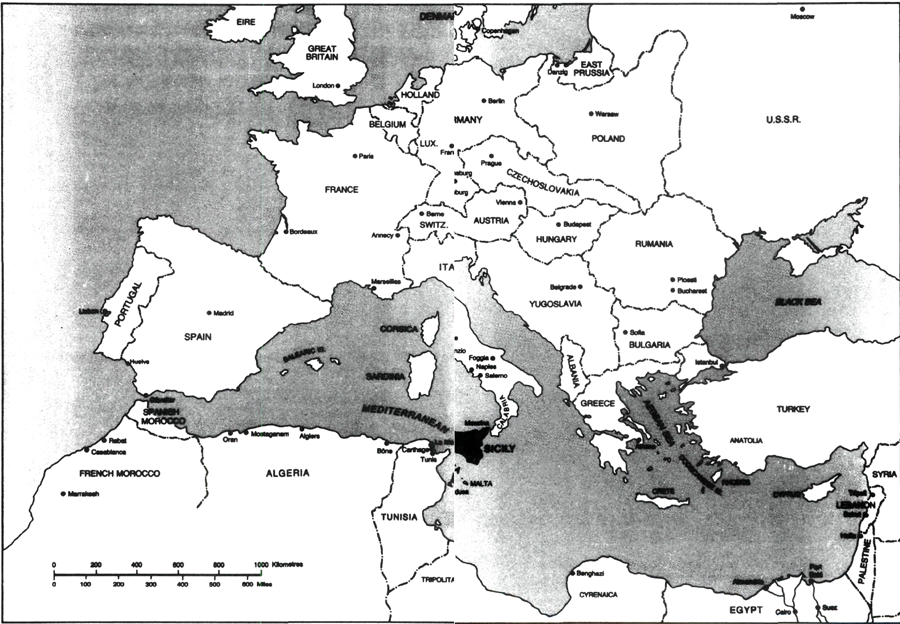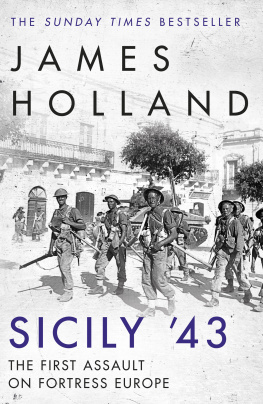BITTER
VICTORY

The Battle for Sicily
JulyAugust 1943
Carlo DEste

For Eleanor
whose remarkable courage
has inspired all who
know her
Contents

The Mediterranean
Sicily
Tunisia
The Evolution of Operation HUSKY
The Final Invasion Plan
The Plain of Catania
The Seventh Army landings
The Gela Counterattack
The Battle for Primosole Bridge
The Primosole Bridgehead
The Primosole Battlefield (three-dimensional view)
Situation Map 18-22 July
The Strait of Messina
The Battle of Troina
The German Evacuation of Sicily
The Combined Chiefs of Staff at Casablanca, January 1943 (Official US Army photograph, Dwight D. Eisenhower Library)
The Allied Commanders-in-Chief, Mediterranean at Casablanca (Official US Army photograph, Dwight D. Eisenhower Library)
American assault troops receive their final briefing (Official US Army photograph National Archives)
USS Robert Rowan exploding off Gela, 11 July (Official US Army photograph, National Archives)
Troops of the Big Red One landing at Gela, 10 July (Official US Army photograph, National Archives)
US self-propelled artillery rolling inland, 11 July (Official US Army photograph, Dwight D. Eisenhower Library)
The II Corps commander, Lieutenant General Omar N. Bradley (Official US Coast Guard photograph, National Archives)
The Seventh Army commander, Lieutenant General George S. Patton, Jr., aboard the Monrovia (Official US Army photograph, National Archives)
Bradley and Patton (Official US Army photograph, Dwight D. Eisenhower Library)
Field Marshal Albert Kesselring, Commander-in-Chief, South (Imperial War Museum)
Colonel Wilhelm Schmalz (Imperial War Museum)
General der Panzertruppen Hans Valentin Hube (Imperial War Museum)
Generalleutnant Fridolin von Senger und Etterlin (Imperial War Museum)
Generalleutnant Paul Conrath (Courtesy of Alfred Otte)
The Axis C-in-C, Sicily, Generale dArmata Alfredo Guzzoni (Interfoto, Milan)
Major General Clarence R. Huebner and Major General Terry de la Mesa Allen (Official US Army photograph, Dwight D. Eisenhower Library)
The Plain of Gela after the battle (Official US Army photograph, National Archives)
German troops in the Fosso Bottaceto, 19 July (Courtesy of Georg Schmitz)
Highway 114 and the Primosole Bridge (Imperial War Museum)
The 30th Corps commander, Lieutenant-General Sir Oliver Leese and Montgomery (Imperial War Museum)
Major General Lucian K. Truscott, Jr., CG, 3rd infantry Division (Official US Army photograph, National Archives)
82d Airborne paratroopers near Abbio Priolo, 11 July (Official US Army photograph, National Archives)
A British officer observing enemy positions on the Plain of Catania (Imperial War Museum)
Royal Artillery gunners on the Catania front (Imperial War Museum)
Major General Troy H. Middleton, CG, 45th Infantry Division, confers with Bradley and Patton (Official US Army photograph, National Archives)
Air Vice-Marshal Sir Arthur Coningham, Allied Tactical Air commander (Official US Army photograph, National Archives)
The 13th Corps commander, Lieutenant-General Miles Dempsey and Major-General Guy G. Simonds, GOC, 1st Canadian Division (Imperial War Museum)
The Eighth Army commander, General Sir Bernard Montgomery (Imperial War Museum)
Major-General Vivian Evelegh and Colonel Paddy Flint meet outside Randazzo (Official US Army photograph, National Archives)
US artillery forward observation post directing fire on Troina (Official US Army photograph, National Archives)
The 1st Infantry Division entering the ruins of Troina, 6 August (Official US Army photograph, National Archives)
Monty explains his strategy for the capture of Messina, 25 July (Official US Army photograph, Dwight D. Eisenhower Library)
The British at Sferro, 25 July (Imperial War Museum)
The 15th Army Group commander, General Sir Harold Alexander and General Dwight D. Eisenhower, Allied C-in-C, Mediterranean (Official US Army photograph, Dwight D. Eisenhower Library)
Patton delivers his famous apology to the 1st Infantry Division, 27 August (Official US Army photograph, Dwight D. Eisenhower Library)
Major General Geoffrey Keyes accepting the surrender of Palermo, 22 July (Official US Army photograph, National Archives)
The captured Italian general Pordnari with his staff (Imperial War Museum)
The citizens of Palermo greet the arrival of the 2nd Armored Division, 22 July (Official US Army photograph, National Archives)
Sicilians and US troops celebrating the liberation of Messina, 17 August (Official US Army photograph, National Archives)
As 1942 drew to a close, the first serious cracks began to appear in the great Nazi war machine which had vanquished Europe and was now attempting to dismember Russia. On the Eastern Front the Wehrmacht now found itself engaged in a life and death struggle against the Red Army. The onset of the harsh Russian winter had left the German Army severely overextended and vulnerable to the great Red Army counteroffensive which, by February 1943, saw the annihilation of Field Marshal Friedrich von Paulus Sixth German Army in the frozen hell of Stalingrad.
In the West a dramatic turnabout in the fortunes of the Allies took place near a wind-blown and fly-infested railroad siding on the Egyptian border with Libya. There, a little known British general led a revitalized Eighth Army to a dramatic victory over Field Marshal Erwin Rommels celebrated Panzer Army Afrika. Thereafter, the names of both El Alamein and Bernard Montgomery were forever immortalized in the annals of military history, and an exultant Churchill later proclaimed that: Before Alamein we never had a victory. After Alamein we never had a defeat.
The British victory at Alamein had strategic results far beyond its immediate significance as the first major setback suffered by Rommel, who was the first senior German commander to foresee Alameins long-term implications. As a result, he urged Hitler to withdraw German forces from North Africa while there was still time. By late 1942, Rommel considered further Axis presence in North Africa a futile gesture and at the Fuehrers headquarters complex near Rastenburg, deep in the forests of East Prussia, he told Hitler that there was no hope of victory and the abandonment of the African theatre of war should be accepted as a long term policy. There should be no illusions about the situation and all planning should be directed towards what was attainable. If the Army remained in North Africa, it would be destroyed.













